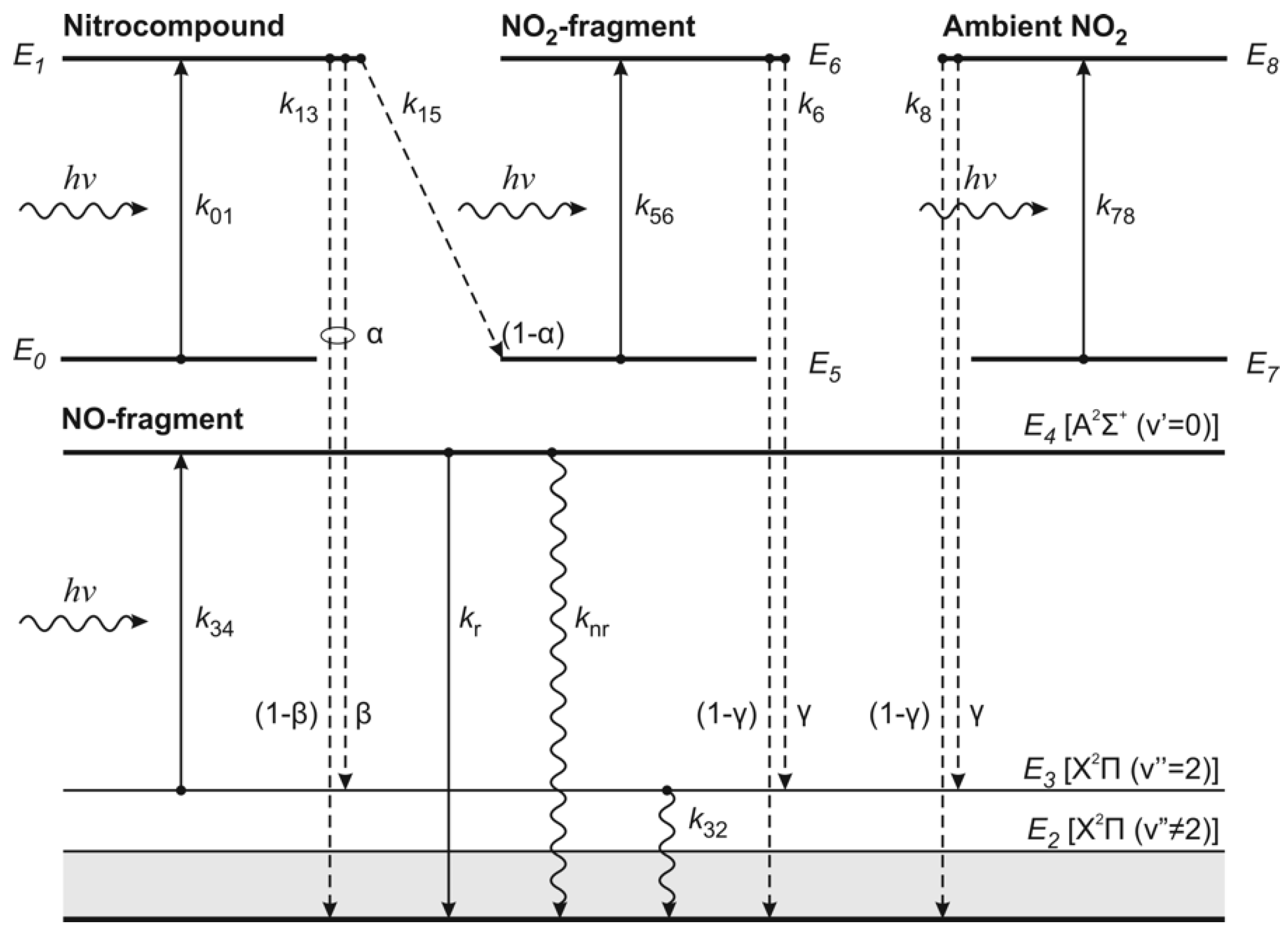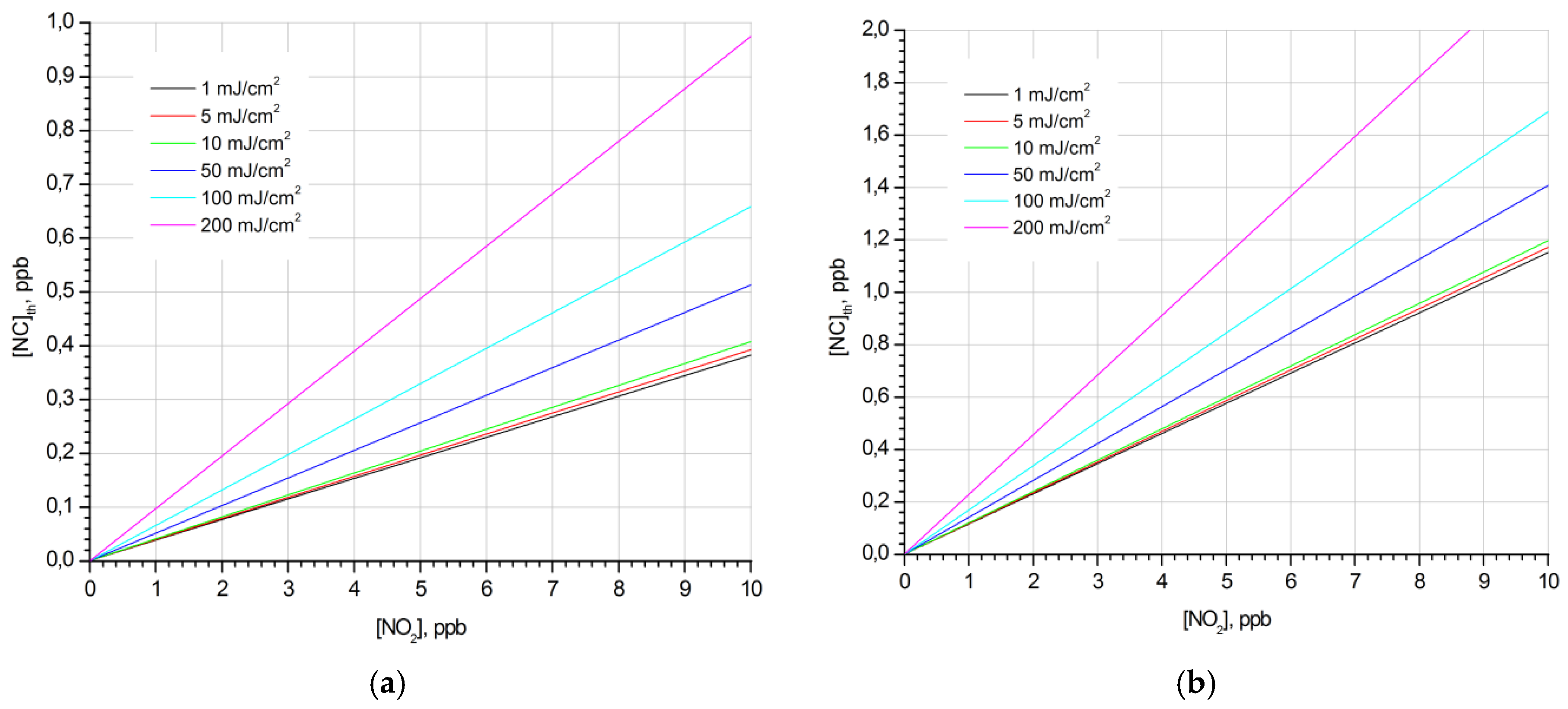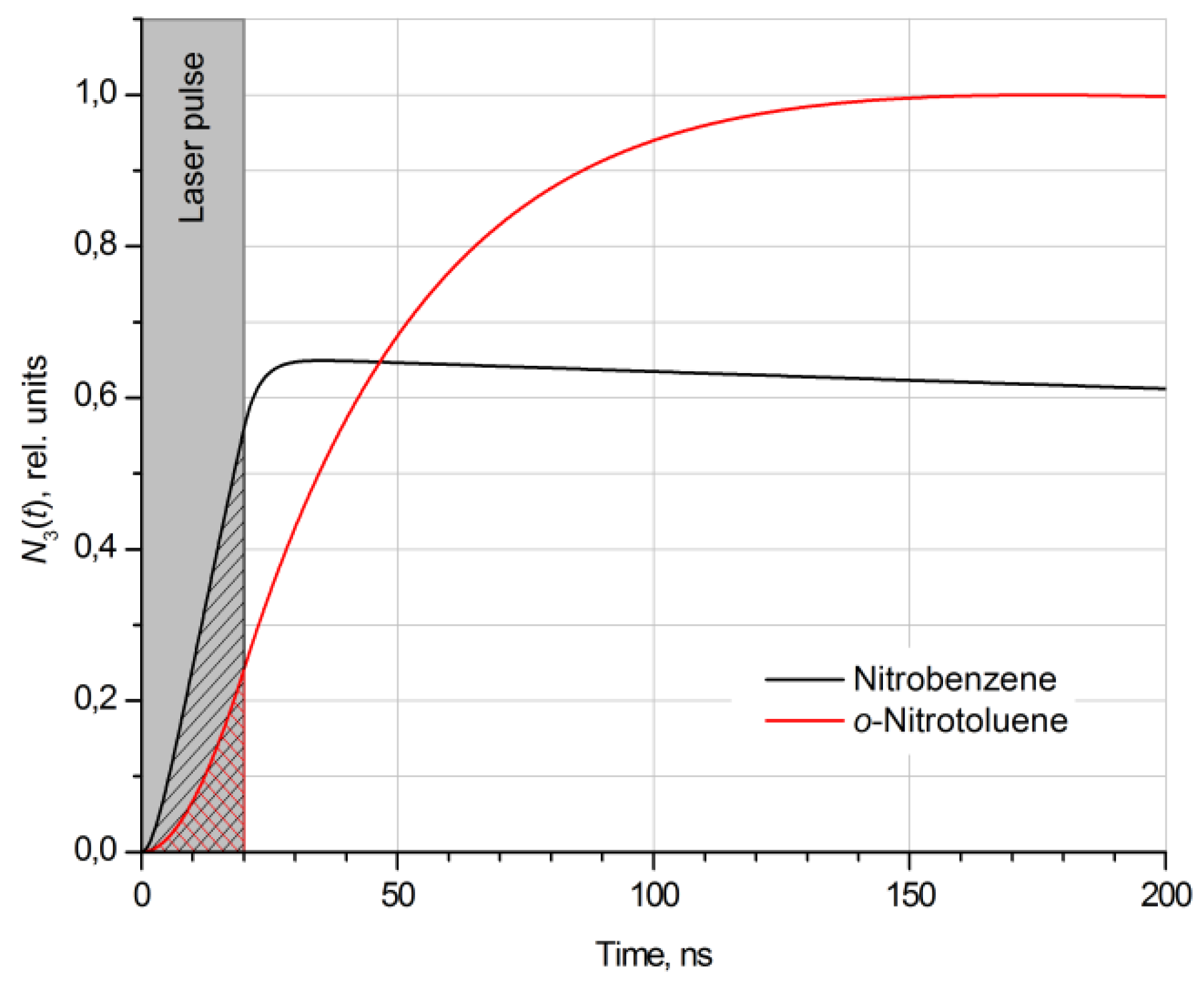Evaluation of Limiting Sensitivity of the One-Color Laser Fragmentation/Laser-Induced Fluorescence Method in Detection of Nitrobenzene and Nitrotoluene Vapors in the Atmosphere
Abstract
:1. Introduction
2. Model of the One-Color LF/LIF Process
3. Results and Discussion
4. Conclusions
Author Contributions
Funding
Conflicts of Interest
References
- Rodgers, M.O.; Asai, K.; Davis, D.D. Photofragmentation-laser induced fluorescence: A new method for detecting atmospheric trace gases. Appl. Opt. 1980, 19, 3597–3605. [Google Scholar] [CrossRef]
- Rodgers, M.O.; Davis, D.D. A UV-Photofragmentation/Laser-Induced Fluorescence Sensor for the Atmospheric Detection of HONO. Environ. Sci. Technol. 1989, 23, 1106–1112. [Google Scholar] [CrossRef]
- Sandholm, S.T.; Bradshaw, J.D.; Dorris, K.S.; Rodgers, M.O.; Davis, D.D. An Airborne Compatible Photofragmentation Two-Photon Laser-Induced Fluorescence Instrument for Measuring Background Tropospheric Levels of NO, NOx, and NO2. J. Geophys. Res. 1990, 95, 10155–10161. [Google Scholar] [CrossRef]
- Galloway, D.B.; Bartz, J.A.; Huey, L.G.; Crim, F.F. Pathways and kinetic energy disposal in the photodissociation of nitrobenzene. J. Chem. Phys. 1993, 98, 2107–2114. [Google Scholar] [CrossRef]
- Lemire, G.W.; Simeonsson, J.B.; Sausa, R.C. Monitoring of vapor-phase nitro compounds using 226-nm radiation: Fragmentation with subsequent NO resonance-enhanced multiphoton ionization detection. Anal. Chem. 1993, 65, 529–533. [Google Scholar] [CrossRef]
- Galloway, D.B.; Glenewinkel-Meyer, T.; Bartz, J.A.; Huey, L.G.; Crim, F.F. The Kinetic and Internal Energy of NO from the Photodissociation of Nitrobenzene. J. Chem. Phys. 1994, 100, 1946–1952. [Google Scholar] [CrossRef]
- Wu, D.D.; Singh, J.P.; Yueh, F.Y.; Monts, D.L. 2,4,6-Trinitrotoluene detection by laser-photofragmentation–laser-induced fluorescence. Appl. Opt. 1996, 35, 3998–4003. [Google Scholar] [CrossRef]
- Simeonsson, J.B.; Sausa, R.C. A critical review of laser photofragmentation/fragment detection techniques for gas phase chemical analysis. Appl. Spectrosc. Rev. 1996, 31, 1–72. [Google Scholar] [CrossRef]
- Swayambunathan, V.; Singh, G.; Sausa, R.C. Laser photofragmentation–fragment detection and pyrolysis–laser-induced fluorescence studies on energetic materials. Appl. Opt. 1999, 38, 6447–6454. [Google Scholar] [CrossRef]
- Daugey, N.; Shu, J.; Bar, I.; Rosenwaks, S. Nitrobenzene detection by one-color laser photolysis/laser induced fluorescence of NO (v = 0-3). Appl. Spectrosc. 1999, 53, 57–64. [Google Scholar] [CrossRef]
- Shu, J.; Bar, I.; Rosenwaks, S. Dinitrobenzene Detection by Use of One-color Laser Photolysis and Laser-Induced Fluorescence of Vibrationally Excited NO. Appl. Opt. 1999, 38, 4705–4710. [Google Scholar] [CrossRef] [PubMed]
- Shu, J.; Bar, I.; Rosenwaks, S. NO and PO photofragments as trace analyte indicators of nitrocompounds and organophosphonates. Appl. Phys. B 2000, 71, 665–672. [Google Scholar] [CrossRef]
- Shu, J.; Bar, I.; Rosenwaks, S. The use of rovibrationally excited NO photofragments as trace nitrocompounds indicators. Appl. Phys. B 2000, 70, 621–625. [Google Scholar] [CrossRef]
- Arusi-Parpar, T.; Heflinger, D.; Lavi, R. Photodissociation Followed by Laser-Induced Fluorescence at Atmospheric Pressure and 24 °C: A Unique Scheme for Remote Detection of Explosives. J. Appl. Opt. 2001, 40, 6677–6681. [Google Scholar] [CrossRef] [PubMed]
- Heflinger, D.; Arusi-Parpar, T.; Ron, Y.; Lavi, R. Application of a unique scheme for remote detection of explosives. Opt. Commun. 2002, 204, 327–331. [Google Scholar] [CrossRef]
- Wynn, C.M.; Palmacci, S.; Kunz, R.R.; Zayhowski, J.J.; Edwards, B.; Rothschild, M. Experimental demonstration of remote optical detection of trace explosives. Proc. SPIE 2008. [Google Scholar] [CrossRef]
- Arusi-Parpar, T.; Fastig, S.; Shapira, J.; Shwartzman, B.; Rubin, D.; Ben-Hamo, Y.; Englander, A. Standoff Detection of Explosives in Open Environment Using Enhanced Photodissociation Fluorescence. Proc. SPIE 2010. [Google Scholar] [CrossRef]
- Wynn, C.M.; Palmacci, S.; Kunz, R.R.; Rothschild, M. Noncontact detection of homemade explosive constituents via photodissociation followed by laser-induced fluorescence. Opt. Express 2010, 18, 5399–5406. [Google Scholar] [CrossRef]
- Wynn, C.M.; Palmacci, S.; Kunz, R.R.; Aernecke, M. Noncontact optical detection of explosive particles via photodissociation followed by laser-induced fluorescence. Opt. Express 2011, 19, 18671–18677. [Google Scholar] [CrossRef]
- Bobrovnikov, S.M.; Gorlov, E.V. Lidar method for remote detection of vapors of explosives in the atmosphere. Atmos. Ocean. Opt. 2011, 24, 235–241. [Google Scholar] [CrossRef]
- Bobrovnikov, S.M.; Vorozhtsov, A.B.; Gorlov, E.V.; Zharkov, V.I.; Maksimov, E.M.; Panchenko, Y.N.; Sakovich, G.V. Lidar detection of explosive vapors in the atmosphere. Russ. Phys. J. 2016, 58, 1217–1225. [Google Scholar] [CrossRef]
- Lin, M.-F.; Lee, Y.T.; Ni, C.-K.; Xu, S.; Lin, M.C. Photodissociation dynamics of nitrobenzene and o-nitrotoluene. J. Chem. Phys. 2007, 126, 064310-1–064310-11. [Google Scholar] [CrossRef] [PubMed]
- Kosmidis, C.; Marshall, A.; Clark, A.; Deas, R.M.; Ledingham, K.W.D.; Singhal, R.P. Multiphoton Ionization and Dissociation of Nitrotoluene Isomers by UV Laser Light. Rapid Commun. Mass Spectrom. 1994, 8, 607–614. [Google Scholar] [CrossRef]
- Weickhardt, C.; Tonnies, K. Short pulse laser mass spectrometry of nitrotoluenes: Ionization and fragmentation behavior. Rapid Commun. Mass Spectrom. 2002, 16, 442–446. [Google Scholar] [CrossRef]
- SenGupta, S.; Upadhyaya, H.P.; Kumar, A.; Dhanya, S.; Naik, P.D.; Bajaj, P. Photodissociation dynamics of nitrotoluene at 193 and 248 nm: Direct observation of OH formation. Chem. Phys. Lett. 2008, 452, 239–244. [Google Scholar] [CrossRef]
- Okabe, H. Photochemistry of Small Molecules; John Wiley and Sons: New York, NY, USA, 1978; pp. 227–235. [Google Scholar]
- Castle, K.J.; Abbott, J.E.; Peng, X.; Kong, W. Photodissociation of o-Nitrotoluene between 220 and 250 nm in a Uniform Electric Field. J. Phys. Chem. A 2000, 104, 10419–10425. [Google Scholar] [CrossRef]
- Morrell, C.; Breheny, C.; Haverd, V.; Cawley, A.; Hancock, G. The 248 nm photolysis of NO2/N2O4: Time-resolved Fourier transform infrared emission from NO and NO2, and quenching of NO (v = 5–8). J. Chem. Phys. 2002, 117, 11121–11130. [Google Scholar] [CrossRef]
- McFarlane, J.; Polanyi, J.C.; Shapter, J.G. Photodissociation dynamics of NO2 at 248 nm. J. Photochem. Photobiol. A Chem. 1991, 58, 139–172. [Google Scholar] [CrossRef]
- Keller-Rudek, H.; Moortgat, G.K.; Sander, R.; Sörensen, R. The MPI-Mainz UV/VIS spectral atlas of gaseous molecules of atmospheric interest. Earth Syst. Sci. Data 2013, 5, 365–373. [Google Scholar] [CrossRef]
- Hancock, G.; Morrison, M.; Saunders, M. Vibrational relaxation of NO (v = 1–16) in collisions with O2 studied by time resolved Fourier transform infrared emission. Chem. Phys. Lett. 2006, 425, 216–220. [Google Scholar] [CrossRef]
- Hallin, K.-E.J.; Merer, A.J. The 2491 A band system of NO2. Rotational structure and evidence for predissociation in the zero-point level. Can. J. Phys. 1976, 54, 1157–1171. [Google Scholar] [CrossRef]
- Luque, J.; Crosley, D.R. Radiative and predissociative rates for NO A2Σ+ v′ = 0–5 and D2Σ+ v′ = 0–3. J. Chem. Phys. 2000, 112, 9411–9416. [Google Scholar] [CrossRef]
- Nee, J.B.; Juan, C.Y.; Hsu, J.Y.; Yang, J.C.; Chen, W.J. The electronic quenching rates of NO (A2Σ+, v′ = 0–2). J. Chem. Phys. 2004, 300, 85–92. [Google Scholar]
- Bobrovnikov, S.M.; Gorlov, E.V.; Zharkov, V.I.; Panchenko, Y.N.; Puchikin, A.V. Dynamics of the laser fragmentation/laser-induced fluorescence process in nitrobenzene vapors. Appl. Opt. 2018, 57, 9381–9387. [Google Scholar] [CrossRef]
- Bobrovnikov, S.M.; Gorlov, E.V.; Zharkov, V.I.; Panchenko, Y.N.; Puchikin, A.V. Two-pulse laser fragmentation/laser-induced fluorescence of nitrobenzene and nitrotoluene vapors. Appl. Opt. 2019, 58, 7497–7502. [Google Scholar] [CrossRef]



| Parameter | Value @ 248 nm | ||
|---|---|---|---|
| NB | o-NT | ||
| absorption cross section of nitrocompound molecule | σabs, 10−18 cm2 | 18 [30] | 14 [30] |
| absorption cross section of NO2 molecule | σNO2, 10−18 cm2 | 0.009 [30] | 0.009 [30] |
| absorption cross section of NO molecule | σNO, 10−18 cm2 | 0.56 1 | 0.56 1 |
| weight coefficient | α | 0.21 [22] | 0.23 [22] |
| weight coefficient | β | 0.1 [10] | 0.1 |
| weight coefficient | γ | 0.1 [28] | 0.1 [28] |
| weight coefficient | φ | 0.7 2 | 0.7 2 |
| absorption rate constant | k01 | σabs × F 3 | |
| absorption rate constant | k56 = k78 | σNO2 × F | |
| absorption rate constant | k34 | σNO × F | |
| dissociation rate constant Nc + hν → R + NO: | k13, s−1 | ||
| fast component | k13fast, s−1 | 2.7 × 107 [22] | 4.5 × 106 [22] |
| slow component | k13slow, s−1 | 6.0 × 103 [22] | 3.2 × 104 [22] |
| dissociation rate constant Nc + hν → R + NO2 | k15, s−1 | 3 × 108 [22] | 2.3 × 107 [22] |
| nonradiative transition rate constant NO (X2Π(v″ = 2)) → NO (X2Π(v″ = 0, 1)) | k32, s−1 | 3.8 × 105 [31] | |
| dissociation rate constant NO2 + hν → NO + O | k6 = k8, s−1 | 2.5 × 1010 [32] | |
| radiative transition rate constant NO (A2Σ+) → NO (X2Π) + hν | kr, s−1 | 4.9 × 106 [33] | |
| nonradiative transition rate constant NO (A2Σ+) → NO (X2Π) | knr, s−1 | 8.1 × 108 [34] | |
| Parameter | Value | |
|---|---|---|
| NB | o-NT | |
| A | 0.03536 | 0.11274 |
| B1 | 2.6 × 10−4 | 5.2 × 10−4 |
| B2 | 1.9 × 10−7 | 2.2 × 10−7 |
| C | 0.001 | 0.001 |
© 2019 by the authors. Licensee MDPI, Basel, Switzerland. This article is an open access article distributed under the terms and conditions of the Creative Commons Attribution (CC BY) license (http://creativecommons.org/licenses/by/4.0/).
Share and Cite
Bobrovnikov, S.; Gorlov, E.; Zharkov, V. Evaluation of Limiting Sensitivity of the One-Color Laser Fragmentation/Laser-Induced Fluorescence Method in Detection of Nitrobenzene and Nitrotoluene Vapors in the Atmosphere. Atmosphere 2019, 10, 692. https://doi.org/10.3390/atmos10110692
Bobrovnikov S, Gorlov E, Zharkov V. Evaluation of Limiting Sensitivity of the One-Color Laser Fragmentation/Laser-Induced Fluorescence Method in Detection of Nitrobenzene and Nitrotoluene Vapors in the Atmosphere. Atmosphere. 2019; 10(11):692. https://doi.org/10.3390/atmos10110692
Chicago/Turabian StyleBobrovnikov, Sergei, Evgeny Gorlov, and Viktor Zharkov. 2019. "Evaluation of Limiting Sensitivity of the One-Color Laser Fragmentation/Laser-Induced Fluorescence Method in Detection of Nitrobenzene and Nitrotoluene Vapors in the Atmosphere" Atmosphere 10, no. 11: 692. https://doi.org/10.3390/atmos10110692
APA StyleBobrovnikov, S., Gorlov, E., & Zharkov, V. (2019). Evaluation of Limiting Sensitivity of the One-Color Laser Fragmentation/Laser-Induced Fluorescence Method in Detection of Nitrobenzene and Nitrotoluene Vapors in the Atmosphere. Atmosphere, 10(11), 692. https://doi.org/10.3390/atmos10110692




